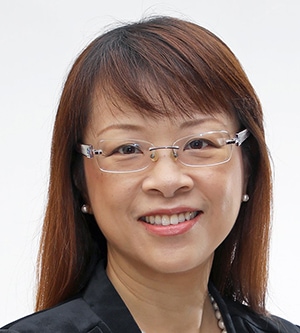Loo Siew Yeen, assistant managing director at the Monetary Authority of Singapore, talks about digital changes and how the central bank is handling spillover effects of the US-China trade war and Hong Kong turmoil.

Global Finance: What is the outlook for Singapore’s economy, given the challenging backdrop of the ongoing US-China trade dispute?
Loo Siew Yee: The current trade spat between the US and China has escalated just as the global economy undergoes a gradual slowing of growth due to downturns in manufacturing, electronics production, and trade. Singapore recently slashed GDP growth expectations to 0.6%, following a previous downgrade just the month before and expectations of 1.5% to 2.5% growth forecast in May.
Singapore could be affected by its exposure to the slowing global economy through several key channels. In the direct channel, dampened Chinese and American demand will affect Singapore-based firms which sell to China and the US. Indirectly, the impact of such tariffs and tech restrictions could reverberate through global supply chains and eventually generate negative spillover effects to Singapore.
GF: How is the Monetary Authority of Singapore approaching the digitization of the banking industry?
Loo: The MAS recently announced the details of five new digital banking licenses, which will mark a new phase in the industry in Singapore, in a bid to take advantage of the ongoing digital revolution in finance. While Singapore is currently well-served by a core group of local and international banks, the entry of new digital players will add diversity and strengthen Singapore’s banking system within the emerging digital economy.
Globally, the financial industry is facing slower economic growth, tighter regulation, and tougher competition. Using business models that differ from those of existing banks and are underpinned by strong digital capabilities, these players can cater to underserved segments of the market, such as start-ups and microenterprises. The digital banks can also provide further impetus for Singapore’s banks to continue upgrading their digital services, making them stronger and more competitive both onshore and across the region.
GF: As a global financial center, how is Singapore coping with the threat of financial crime, especially in light of digital transformation?
Loo: Financial institutions in Singapore are facing increasingly complex and fast-evolving financial-crime threats, which can be facilitated by highly sophisticated techniques to disguise illicit assets and transactions. MAS expects financial institutions to proactively detect and disrupt financial crime by taking appropriate risk mitigation measures, and promptly alerting the authorities to suspicious activities. To be more effective at countering these risks, Singapore authorities and financial institutions have also made greater use of data analytics and deepened public-private collaboration.
In using data analytics, banks are applying machine learning techniques to detect and focus resources on higher-risk alerts and reduce false positives. Banks are also using network analysis tools to detect hidden relationships between customers. Through these efforts, banks can better avoid bad customers, monitor higher-risk customers, and strengthen relationships with legitimate customers.
GF: How do international investors view Singapore from a credit perspective?
Loo: Given the interdependence of Asia’s economies in terms of trade and investment ties, investors tend to view the region as a bloc as far as risk perception is concerned. In times of stress, general risk aversion increases towards Asia as a whole, to the detriment of individual regional markets and countries’ investment flows. While it would be tempting to suggest that the recent turmoil in Hong Kong, which has prompted talk of the emigration of people and capital to the stability of Singapore, the MAS is keen to downplay that speculation.



